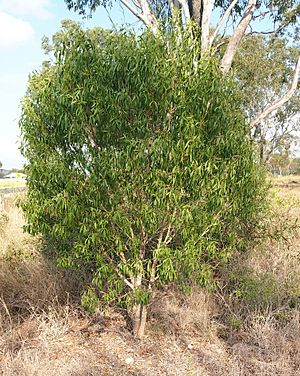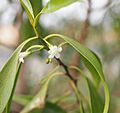Waterbush facts for kids
Quick facts for kids Boobialla |
|
|---|---|
 |
|
| Scientific classification | |
| Genus: |
Myoporum
|
| Species: |
montanum
|
| Synonyms | |
Myoporum montanum, often called waterbush or boobialla, is a type of shrub that grows naturally in Australia, New Guinea, and Timor. This plant can look very different in size, how it grows, and the shape of its leaves. There are three main forms of the plant. You often find it near coasts, rivers, and other places where there is plenty of water. This is why it got the name "waterbush."
Contents
What Boobialla Looks Like
Boobialla grows as a smooth, hairless shrub or a small tree. It can reach up to 8 meters (about 26 feet) tall. It can be tricky to tell it apart from another plant called Myoporum acuminatum, and they often grow in the same areas.
Boobialla usually has smaller, thinner leaves. The leaf-like parts that protect its flower bud, called sepals, do not have clear edges like those of M. acuminatum. Also, Boobialla's fruit is pink or light purple, while M. acuminatum has dark purple or blue fruit.
The leaves of the waterbush can vary in shape. They are often long and thin, or oval-shaped. They usually get narrower towards the tip. You can only see the main vein on the underside of the leaf. These leaves are typically about 45 to 100 mm (1.8 to 3.9 inches) long and 5 to 21 mm (0.2 to 0.8 inches) wide. They are smooth and hairless, the same color on both sides, and have smooth edges.
Sweet-smelling flowers grow in groups of one to five. They appear where the leaf meets the stem, on stalks about 4.5 to 11 mm (0.18 to 0.43 inches) long. Each flower has five, sometimes six, white petals. These petals might have rows of purple spots. The petals form a tube about 2 to 5 mm (0.08 to 0.20 inches) long, with lobes (parts of the petal) that are about the same length. The whole flower is about 6 to 8 mm (0.24 to 0.31 inches) wide.
Boobialla mostly flowers in winter and summer. After flowering, it produces fruits. These fruits are smooth or slightly rough, fleshy fruits with a hard pit inside, called drupes. They are oval-shaped, about 5 to 8 mm (0.20 to 0.31 inches) wide. Their color can be light purple, red-purple, or brown. A small part of the flower, called the style, often sticks out from the fruit.
There are three main forms of this plant, identified by a scientist named Robert Chinnock:
- Type form: Found in the Blue Mountains. It has narrow, thin leaves and small flowers with few or no spots.
- Desert form: Found in dry areas of Australia. This is a large shrub or small tree with thick, oval leaves. Its flowers have clear purplish-red spots.
- Tropical form: Found in northern Australia, New Guinea, and Timor. It has thin leaves and very small, plain white flowers.
How Boobialla Got Its Name
The scientific name Myoporum montanum was first officially described by Robert Brown in 1810. He published this description in a book called Prodromus Florae Novae Hollandiae. The second part of its scientific name, montanum, comes from a Latin word meaning "pertaining to or growing on mountains."
Where Boobialla Grows
Waterbush grows in all mainland states of Australia. You can also find it in some parts of New Guinea and Irian Jaya, and there is one record from Timor. It is very common in eastern Queensland, New South Wales, and eastern South Australia.
This plant can grow in many different types of environments. These range from mangrove swamps to rainforests and even the Simpson Desert. It can grow in many different kinds of soil. In other parts of Australia, New Guinea, and Timor, it mostly grows near coasts, rivers, and other places with a steady water supply.
Boobialla in Nature
The fruits of the waterbush are a food source for many birds, including emus. Aboriginal people also ate these fruits. However, the nutritional value of the fruits is considered low. It's also known that some plants in this group can contain substances that are not good for the liver if eaten. People have described the taste as "bitterly aromatic and salty sweet."
Growing Boobialla in Gardens
Waterbush is a strong plant that is easy to grow in gardens. It can handle dry conditions well. It makes a good screen plant in drier areas and is easy to grow from cuttings (small pieces of the plant).
Images for kids
See also
 In Spanish: Banksia occidentalis para niños
In Spanish: Banksia occidentalis para niños



